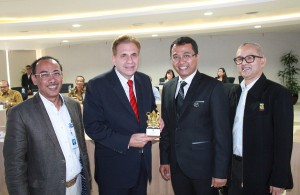 John D Kasarda presented business Aerotroplis concept at SBM ITB Jakarta campus (25/6/14). The leading developer of the Aerotropolis concept visited Indonesia to support Angkasa Pura II in developing Aerotropolis concept for Soekarno-Hatta airport. Aerotropolis is defined as a multimodal freight and passenger transportation complex which support efficient, cost-effective, sustainable development in a defined region of economic, significance centered around a major airport.
John D Kasarda presented business Aerotroplis concept at SBM ITB Jakarta campus (25/6/14). The leading developer of the Aerotropolis concept visited Indonesia to support Angkasa Pura II in developing Aerotropolis concept for Soekarno-Hatta airport. Aerotropolis is defined as a multimodal freight and passenger transportation complex which support efficient, cost-effective, sustainable development in a defined region of economic, significance centered around a major airport.
 John D Kasarda presented business Aerotroplis concept at SBM ITB Jakarta campus (25/6/14). The leading developer of the Aerotropolis concept visited Indonesia to support Angkasa Pura II in developing Aerotropolis concept for Soekarno-Hatta airport. Aerotropolis is defined as a multimodal freight and passenger transportation complex which support efficient, cost-effective, sustainable development in a defined region of economic, significance centered around a major airport.
John D Kasarda presented business Aerotroplis concept at SBM ITB Jakarta campus (25/6/14). The leading developer of the Aerotropolis concept visited Indonesia to support Angkasa Pura II in developing Aerotropolis concept for Soekarno-Hatta airport. Aerotropolis is defined as a multimodal freight and passenger transportation complex which support efficient, cost-effective, sustainable development in a defined region of economic, significance centered around a major airport.
To begin with, Salahudin Rafi, Director of Airport Development and Technology, opened the 3-hour seminar. “Now we are (Angkasa Pura II) focusing on the exploring the concept of Aerotropolis and we are supported by John Kasarda. We must have a new concept to the Kualanamu airport to become the 2nd international airport in Indonesia opened in July 2013. Kualanamu airport is the first airport in Indonesia which has direct express rail to the city,” said Rafi, the Alumni of MBA ITB. On his presentation, he showed the airport city development concept of Kualanamu airport located near to the business park, cargo terminal logistic, leisure entertainment park, apartment, and hotel.
“An Aerotropolis can be defined as a multimodal freight and passenger transportation complex which support efficient, cost-effective, sustainable development in a defined region of economic, significance centered around a major airport. But, it is more than a transport complex, it is a strategy to the airport become more functional for regional economic development. That is, an Aerotropolis is a constellation of physical, institutional, and policy interventions which upgrade airport infrastructure and facilities reduce connecting ground based transport times and cost and expand air route connectivity to improve operational efficiencies to the airport and metropolitan region and leverage aviation enables trade in goods and services,” said John Kasarda to start his presentation.
“Key value proposition of Aerotropolis offers businesses located near or with good transport access to the airport with speedy connectivity to their supplier, customers, and enterprise partners, nationality and worldwide. The Aerotropolis contains the full set of cargo, logistic, and commercial facilities that support airlines and aviation linked businesses as well as air travelers. An airport city developed on and immediately around the airport serves as the multimodal, multifunctional commercial and logistic core,” explained the Director of the Center for Air Commerce at UNC’s Kenan Institute of Private Enterprise.
Continued his presentation John said that the Aerotropolis has three forms, there are:
1. Functional Form
- Non Spatial (non observable)
2. Physical Form
- Spatially Observable Development
3. Connection/Linkages
- Air Routes
- Highways
- Rail Networks
- Links to Ports
“Airports today much more than aviation infrastructures. They are multimodal, multifunctional enterprises generating considerable commercial development within and well beyond their boundaries. All commercial functions of a modern metropolitan center are locating on and immediately around major airport sites – transforming them from “city airports” to “airport cities,” shared John Kasarda the author of books titled, Aerotropolis: The Way We’ll Live Next.
John, also noted the Aerotropolis Critical points for Indonesia:
- It’s more than about commercially developing the airport area.
- Indonesia’s global competitiveness rests with understanding and implementing the Aerotropolis model.
- Companies no longer compete – their supply chains and enterprise networks, physically moving products and people quickly around the world.
- Aviation is Indonesia’s high speed physical internet and airports are its routers.
- To maximize nation-wide competitiveness and development impact, create an Indonesia Global – Link System through CGK providing speed, agility, connectivity for all major islands to the global marketplace. Then develop multiple hubs in the decades ahead.
“The Aerotropolis is a process, not a project. Built on a strategic roadmap, business logic and stakeholder alignment. It requires leadership, organization, funding and a strong ongoing public-private sector commitment. It facilitates economic transformation leading to greater regional competitiveness and prosperity,” said John emphasizing the Aerotropolis concept.
On the last part of presentation John shared the concluding points to competing and winning in the 21st century, there are:
- Economic transformation requires an economic engine.
- Airports has become primary 21st century economic engines.
- The Aerotropolis strategy maximizes the power of these engines.
- This strategy may provide the most opportune pathway to Indonesia’s business competitiveness and regional economic development in the decades ahead.
- It won’t be easy and other Asian competitors are implementing the strategy with great commitment and resources.

To begin with, Salahudin Rafi, Director of Airport Development and Technology, opened the 3-hour seminar. “Now we are (Angkasa Pura II) focusing on the exploring the concept of Aerotropolis and we are supported by John Kasarda. We must have a new concept to the Kualanamu airport to become the 2nd international airport in Indonesia opened in July 2013. Kualanamu airport is the first airport in Indonesia which has direct express rail to the city,” said Rafi, the Alumni of MBA ITB. On his presentation, he showed the airport city development concept of Kualanamu airport located near to the business park, cargo terminal logistic, leisure entertainment park, apartment, and hotel.
“An Aerotropolis can be defined as a multimodal freight and passenger transportation complex which support efficient, cost-effective, sustainable development in a defined region of economic, significance centered around a major airport. But, it is more than a transport complex, it is a strategy to the airport become more functional for regional economic development. That is, an Aerotropolis is a constellation of physical, institutional, and policy interventions which upgrade airport infrastructure and facilities reduce connecting ground based transport times and cost and expand air route connectivity to improve operational efficiencies to the airport and metropolitan region and leverage aviation enables trade in goods and services,” said John Kasarda to start his presentation.
“Key value proposition of Aerotropolis offers businesses located near or with good transport access to the airport with speedy connectivity to their supplier, customers, and enterprise partners, nationality and worldwide. The Aerotropolis contains the full set of cargo, logistic, and commercial facilities that support airlines and aviation linked businesses as well as air travelers. An airport city developed on and immediately around the airport serves as the multimodal, multifunctional commercial and logistic core,” explained the Director of the Center for Air Commerce at UNC’s Kenan Institute of Private Enterprise.
Continued his presentation John said that the Aerotropolis has three forms, there are:
1. Functional Form
- Non Spatial (non observable)
2. Physical Form
- Spatially Observable Development
3. Connection/Linkages
- Air Routes
- Highways
- Rail Networks
- Links to Ports
“Airports today much more than aviation infrastructures. They are multimodal, multifunctional enterprises generating considerable commercial development within and well beyond their boundaries. All commercial functions of a modern metropolitan center are locating on and immediately around major airport sites – transforming them from “city airports” to “airport cities,” shared John Kasarda the author of books titled, Aerotropolis: The Way We’ll Live Next.
John, also noted the Aerotropolis Critical points for Indonesia:
- It’s more than about commercially developing the airport area.
- Indonesia’s global competitiveness rests with understanding and implementing the Aerotropolis model.
- Companies no longer compete – their supply chains and enterprise networks, physically moving products and people quickly around the world.
- Aviation is Indonesia’s high speed physical internet and airports are its routers.
- To maximize nation-wide competitiveness and development impact, create an Indonesia Global – Link System through CGK providing speed, agility, connectivity for all major islands to the global marketplace. Then develop multiple hubs in the decades ahead.
“The Aerotropolis is a process, not a project. Built on a strategic roadmap, business logic and stakeholder alignment. It requires leadership, organization, funding and a strong ongoing public-private sector commitment. It facilitates economic transformation leading to greater regional competitiveness and prosperity,” said John emphasizing the Aerotropolis concept.
On the last part of presentation John shared the concluding points to competing and winning in the 21st century, there are:
- Economic transformation requires an economic engine.
- Airports has become primary 21st century economic engines.
- The Aerotropolis strategy maximizes the power of these engines.
- This strategy may provide the most opportune pathway to Indonesia’s business competitiveness and regional economic development in the decades ahead.
- It won’t be easy and other Asian competitors are implementing the strategy with great commitment and resources.




